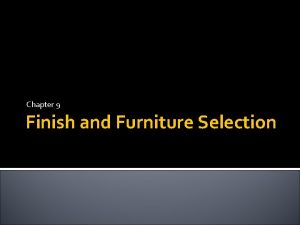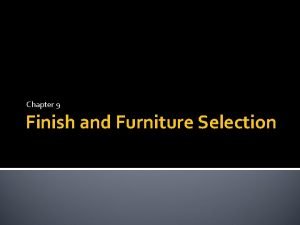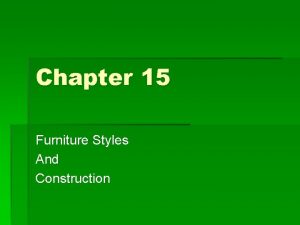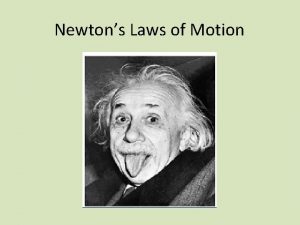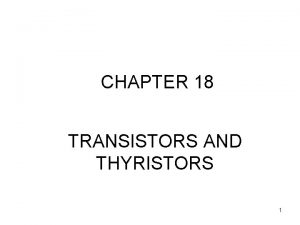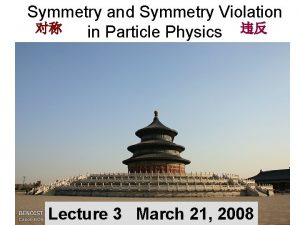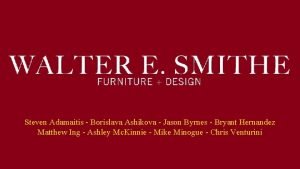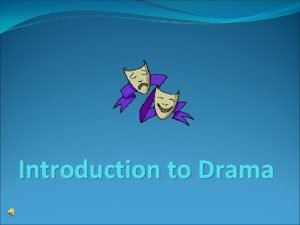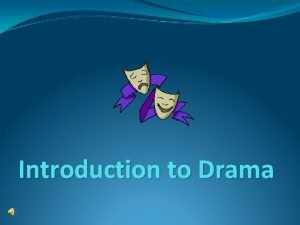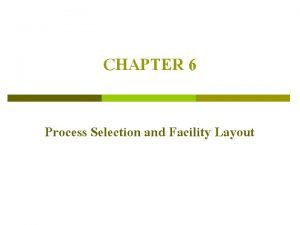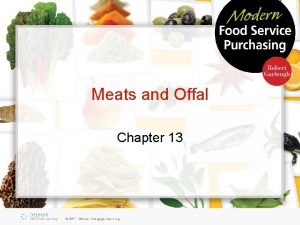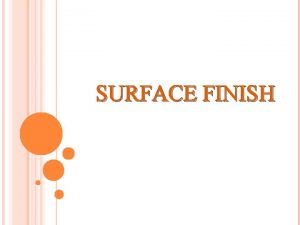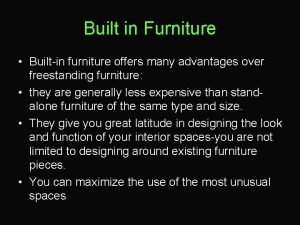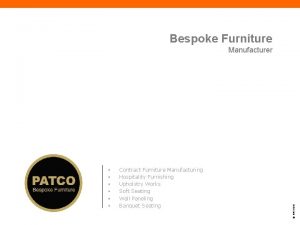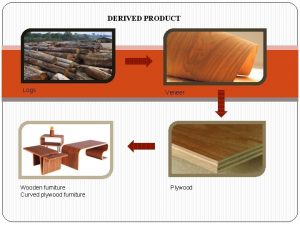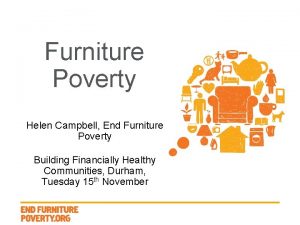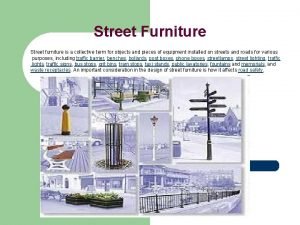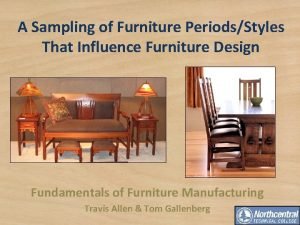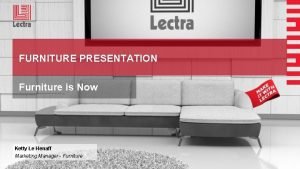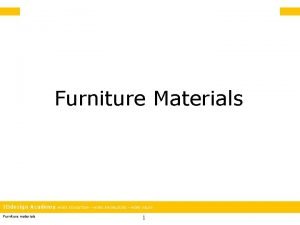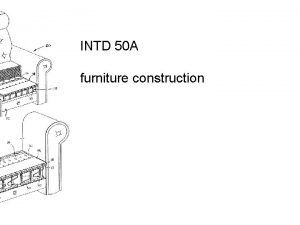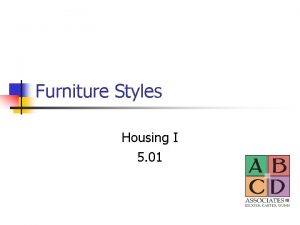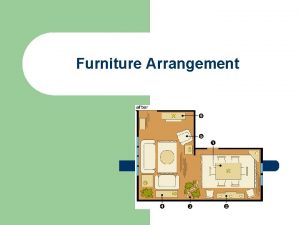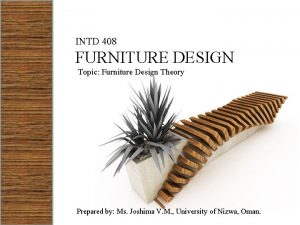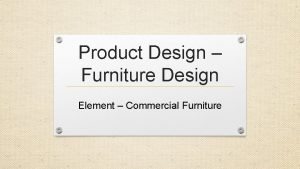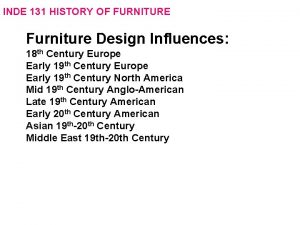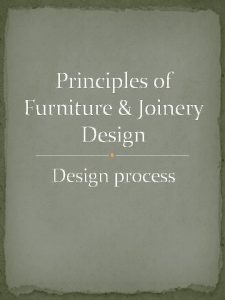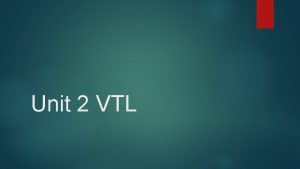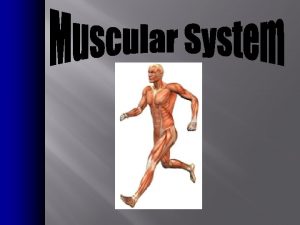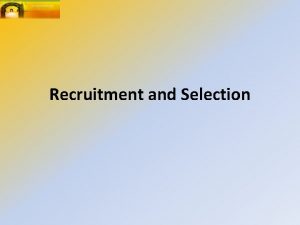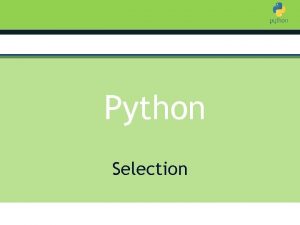Chapter 9 Finish and Furniture Selection Introduction Approximately


































- Slides: 34

Chapter 9 Finish and Furniture Selection

Introduction Approximately 75% of all codes deal with fire and life safety. The ultimate goal of the fire codes is to confine a fire to the room of origin, and therefore limit the spread of the fires and prevent flashover.

Background There approximately 3, 500 deaths in the US each year due to fires, most of which are residential. 74% of structural fires are residential Causes of fires are: cooking, smoking, heating and arson. The first 5 -10 minutes of a fire are the most critical. The products that a designer specifies can either contribute to the growth or prevent it’s spread. All the components a designer specifies become crucial elements in the early stages of a fire.

Stages of a Fire Stage I: time of ignition and initial fire growth. A fire-suppression method should seek to extinguish the fire while it is contained. Stage II: The growth stage. This is when the fires starts to ignite other materials in the immediate area to include the finishes, fabrics and furnishings. Stage III: During this stage, the fire is fully developed. Extreme smoke and toxic gasses are throughout.

How codes address fire and smoke They place strict requirements on the materials that are used to construct a building as well as the materials used inside the building. Fire ratings are assigned to various types of construction types. Type I is the strictest and Type V is the least restrictive. (Chapter 3)

Smoke and Toxic Gasses Smoke control is a relatively new field compared to fire control. Codes are now including smoke control because more people die from asphyxiation (carbon monoxide poisoning) due to smoke than from burns. Toxicity of smoke is a large factor Smoke travels quickly Smoke causes obstruction of sight

Cocoanut Grove One of the worst fires in American history. In the early days of WWII, on November 28 th, 1942, more than 1, 000 were celebrating. Fire started when a busboy lit a match to see to replace a light bulb. The flammable paper palm trees caught fire and the satin ceiling fabric help spread the fire.

Cocoanut Grove Many lives could have been saved, but 492 died that night due to lack of exit lighting, locked exit doors, revolving doors and doors that opened inward. Also, the occupancy load for the club was only 460. Major steps in fire prevention followed this fire to include (Boston Fire Code): emergency lighting, placing O. L. place cards, Exit signs, banning flammable decorations, and outward swinging doors adjacent to revolving doors.

Beverly Hills Super Club Beverly Hills Supper Club: (Kentucky, 1977) 164 die from smoke inhalation. Smoke was carried through air ducts and toxin killed many guests while seated at their tables.


Code Violations Carpeting and paneling did not meet code No sprinkler system 4 th exit required in Cabaret Room OL: of 511 was more than double



Beverly Hill Super Club

The Station (Night Club Fire) February 20, 2003 in Rhode Island Pyrotechnics (Great White) starts fire through contact with flammable sound proofing materials. Within 3 minutes, building was on fire with toxic smoke spreading through the building.

The Station

The Station 100 people died from this fire, had a sprinkler system been in place, the deaths would not have happened.

The Station

Interior Finishes and Furniture Many fatal fires have been attributed to the finishes and upholstery used in its interior. Boston’s Cocoanut Grove Night Club burned in 1942 killing 492. In response to this fire, Boston created the Boston Fire Code which regulates interior finishes. Codes give strict instruction on the selection of finishes since they often ignite and rapidly spread a fires. Example: Using a wallcovering that is not flame resistant could spread a fires very rapidly down a long corridor.

Types of finishes that are regulated: Ceilings finishes: suspended ceilings, soffits, beams Wall finishes: wall coverings, movable wall partitions, columns Floor finishes: floor coverings, ramps, stair risers Window coverings: Draperies, blinds, shutters Furniture Finishes: exposed and unexposed surfaces (fabrics, wood veneers, laminates, foam drapery linings, etc. ) Furniture: whole pieces, mattresses, padding, assemblies

Finish Codes The two main sources for interior finish regulations are building codes and the LSC (Life Safety Codes. NFPA 101) Many individual cities have adopted their own regulation. Some of the most stringent are California, Boston, New York, Florida, Massachusetts and New Jersey. Most codes are not very detailed, but rather they refer you to a number of standards that you must follow. Remember, the codes set minimum standards.

Steiner Tunnel Test Also known as ASTM E-84, NFPA 255, or UL 723. Develop by A. J. Steiner for the Underwriters Laboratories after WWI. Adopted by ASTM and NFPA in 1958. It’s purpose is to test the surface burning characteristics of wall and ceiling finishes during a stage II fire. It provides data on flame spread (the speed at which a fire may spread) and smoke density (how much visibility there is in a given access route). Procedure: 24’ long sample x 20” wide is place on the ceiling of a long tunnel. Double gas burners are ignited for a 10 minute duration. Air is introduced into the tunnel at the other end to pull the gas flame upstream about 4’. The distance of the burn on the test sample is measured to determine the flame spread.

Steiner Tunnel Test

Steiner Tunnel Test ASTM E-84 All materials are rated on a scale ranging from 0 to 200. The test material is compared to two materials Glass reinforced cement board (rated 0, does not burn) Red oak flooring (rated 100, medium) All wall and ceiling finishes will be rated into one of three classifications. Class A: Flame Spread rating of 0 -25, smoke density of 0 -450 Class B: Flame Spread rating of 26 -75, smoke density of 0 -450 Class C: Flame spread of 76 -200, smoke density of 0 -450.

Radiant Panel Test Also known as ASTM E 648. Used to rate interior floor finishes. It’s purpose deals specifically with measuring flame spread in a corridor or exit way which is under the influence of a fully developed fire in an adjacent room. The fully developed fire transmits heat and radiant energy to the ceilings and walls of the corridor, which ignite the carpet, thus blocking the means of escape. Not all spaces require this test, only exits and access to exits are typically regulated. The higher the number, the more resistant the carpet is to flame. The lower the number, the more likely it will spread flame Two Classifications Class I: Critical radiant flux, minimum of. 45 watts per square centimeter (Hospitals and nursing homes). Class II: Critical radiant flux, minimum. 22 watts (commercial building and hotels)

Methenamine Pill Test Also referred to as DOC FF 1 -70 (wall to wall carpeting), DOC FF-2 -70 (rugs) All carpet manufacturers are required, since 1971, to meet these regulations. Purpose is to prevent the use of highly flammable fibers from spreading flames in a stage I fire. 9 x 9 carpet sample is placed in a 1’ draftprotected square enclosed cube, which is open in the top. Sample is held in place by a 9” metal piece with an 8” hole in the center. A timed methylamines pill is placed in the center. To pass, the surface flame should not burn to within 1” of the metal plate. Must pass 7 out of 8 times If it fails, it must be labeled as flammable. Small rugs less than 24 sq. feet do not have to pass but must be labeled

Vertical Flame Test Also known as NFPA 701 Required for all vertical treatments in which exposed air is on both sides. Includes curtains, draperies, window shades, and large wall hangings. Pass/Fail Test is divided into two methods Test Method 1: small scale- lighter weight (20. 5 oz. yard) Test Method 2: Larger scale – heavier weight When vertical treatments cover a large area, they may also be required to pass the Steiner Tunnel Test.

Corner Test Must be used when napped, tufted, or looped textiles or carpets are used on walls and ceilings. • Textile based NFPA 265 • Non-textile based NFPA 286 Determines how a material will add to fire growth (including heat and smoke), off gas and cause fire spread beyond initial fire location. It is a pass/fail test.

Smolder Test CAL 116 and CAL 117 A pass-fail test used on textiles that measures the char size left on the fabric Test applies to fabrics, welt cords, decking materials, filling and paddings material. Class I passes, Class II does not pass Uses a lit cigarette as the ignition source to see if it will ignite or extinguish.

CAL 133 California Technical Bulletin 133 First test of its kind to test an entire piece of furniture – mock-up Intended for furniture in public building in any area or room that contains 10 or more pieces of seating furniture. It is a flame resistance test that measures carbon monoxide, heat generation , smoke, temperature and weight loss of an entire piece of furniture. Not a requirement typically in building codes.

Summary of Finish Regulations

Using the Code First you must know the occupancy classifications of your building and whether it is considered new or existing. Then you can refer to the table to determine the appropriate class rating Table is on page 402 See example on page 404. See other restrictions on page 416.

Interior Finishes

Example – Grade School
 Natural selection furniture
Natural selection furniture Natural selection furniture
Natural selection furniture Two way selection and multiway selection in c
Two way selection and multiway selection in c Multiway selection in c
Multiway selection in c Mass selection and pure line selection
Mass selection and pure line selection Chapter 15 furniture styles and construction answer key
Chapter 15 furniture styles and construction answer key Balancing selection vs stabilizing selection
Balancing selection vs stabilizing selection Artificial selection vs natural selection
Artificial selection vs natural selection K selection r selection
K selection r selection Natural selection vs artificial selection
Natural selection vs artificial selection Difference between continuous and discontinuous variation
Difference between continuous and discontinuous variation 5 points of natural selection
5 points of natural selection K selection r selection
K selection r selection Natural selection vs artificial selection
Natural selection vs artificial selection Difference between selection and recruitment
Difference between selection and recruitment 1750s music
1750s music The earth formed approximately
The earth formed approximately Pinch off voltage
Pinch off voltage Characteristics of unstable air aviation
Characteristics of unstable air aviation Luke autbeloe drops an approximately
Luke autbeloe drops an approximately Water covers approximately
Water covers approximately Oceans cover approximately
Oceans cover approximately The value of vgs that makes is approximately zero
The value of vgs that makes is approximately zero A charm quark has a charge of approximately
A charm quark has a charge of approximately Which is approximately equal to sin a
Which is approximately equal to sin a Otto emissions is driving his car at 25.0 m s
Otto emissions is driving his car at 25.0 m s A hydrogen atom has a diameter of about 10 nm
A hydrogen atom has a diameter of about 10 nm Walter e smithe brothers
Walter e smithe brothers Difference between play and drama
Difference between play and drama The scenery backdrops and furniture that create the setting
The scenery backdrops and furniture that create the setting Chapter 6 employee testing and selection ppt
Chapter 6 employee testing and selection ppt Process selection and facility layout
Process selection and facility layout Layout
Layout Define offal
Define offal What is a task and finish group nhs
What is a task and finish group nhs
